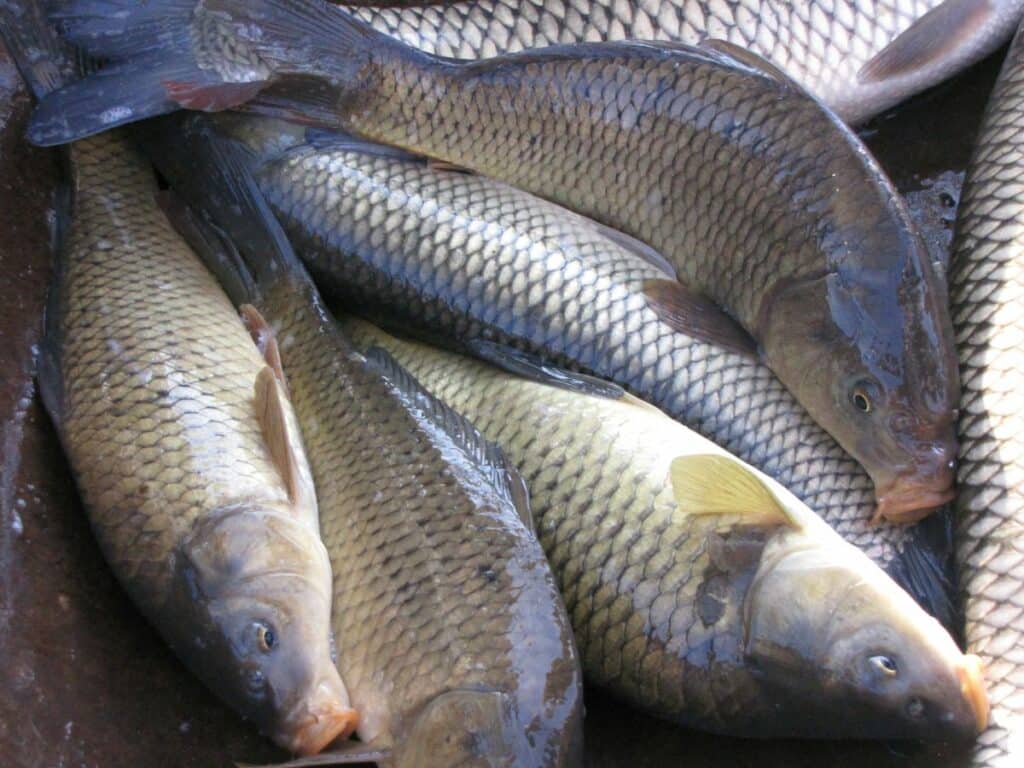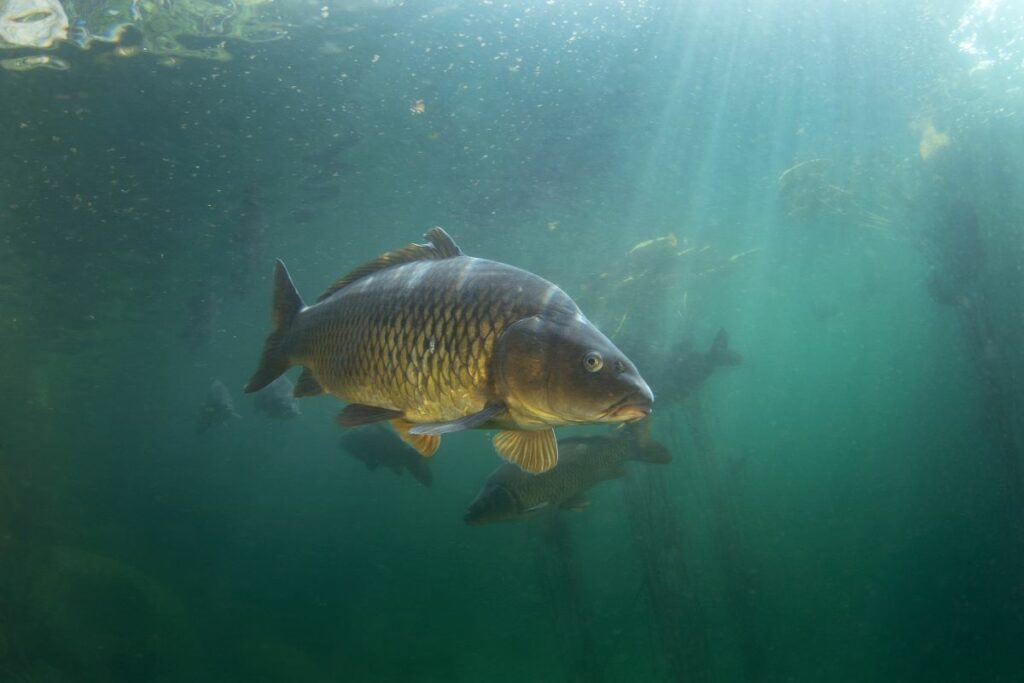the essentials in brief
Grass carp and common carp are two different types of carp fish that are often confused as they share similar characteristics. Here you can find some differences.
The common carp is an omnivore, which means it can include a wide range of foods in its diet. Learn more here.
The size that common carp can reach varies greatly depending on several factors such as habitat, food availability, growing conditions and genetic variation. You can find out more here.
The scaly carp is a special sea creature. The world of aquatic fauna is rich in fascinating creatures, many of which remain hidden in the depths of the waters.
One of these amazing residents is the scaly carp, a fish that is not only of interest to anglers, but one too important role in the aquaculture landscape spielt.
The basics of the scale carp
The common carp, known scientifically as "Cyprinus carpio", is a Freshwater fish from the carp family. Originally native to Asia, the common carp can now be found in waters all over the world.
Characteristic of this species are the conspicuous scales, which cover her body and give it a lustrous, iridescent sheen. The coloring can vary from a bright gold to a dull gray.
Aquaculture and economic importance

Not only does the common carp have a long history as a target fish for anglers, but they do too enormous economic importance in aquaculture. In many countries it is specifically bred to meet the increasing demand for fish products.
Because of his Adaptability to different environments and its rapid growth rate makes it an ideal candidate for aquaculture.
Additional information: Not only prized for its flavorful meat, but also for its ability to thrive in a variety of water conditions.
Diet of the common carp
The scale carp is a omnivore, meaning he can include a wide range of foods in his diet.
Be flexible digestive tract and its adapted mouth allow it to consume both plant and animal foods. Here are some of the main components in the common carp's diet:
1. Plant Food:
- Aquatic Plants: Common carp feed on various types of aquatic plants, including algae, floating leaves, duckweed and other aquatic vegetation.
- Plant debris: They also eat dead or fallen plant parts that are floating in the water.
2. Animal Food:
- Insects and Larvae: Common carp eat insects, their larvae and other invertebrates that live on or below the water surface.
- Worms: Small worms that live in the mud or sediment are also part of their diet.
- Small Fish: While not primarily dependent on fish, scale carp may occasionally eat small fish or fish spawn.
3. Aquatic Organisms:
- Crustaceans: Shrimp, crabs and other small crustaceans are among the prey of the common carp.
- Molluscs: Snails and mussels are also part of their diet, which they ingest by sucking or grazing.
4. Waste materials:
- Scale carp are also known to gather food from debris and debris on the bottom of the water body. This can be organic waste, leftover food or other substances.
Attention: The common carp's versatile diet allows it to survive and thrive in a variety of habitats.
Environmental Impact and Conservation
Although the common carp is economically important, there are also concerns about it potential negative impact on the environment. In some regions to which the common carp has been introduced, it has established itself as a invasive species proven and may affect local wildlife.
It can disrupt the food chain, cause water quality problems and threaten the habitat of other species. Therefore, introducing common carp to new waters is important carefully monitored and regulatedto minimize ecological damage.
The size of the scaly carp
The size that common carp (Cyprinus carpio) can reach varies heavily dependent on various factors such as habitat, food availability, growing conditions and genetic variation. As a rule, however, scale carp can reach considerable sizes.
Here is some general information on scale carp size:
1. Natural Habitats: In the wild, common carp can reach different sizes, depending on the environmental conditions. In smaller bodies of water such as ponds or rivers, they can usually reach an average length of 30 to 60 cm. However, in larger bodies of water such as lakes or rivers with sufficient food availability, common carp can grow much larger.
2. Aquaculture: In aquaculture, where common carp are purposefully bred to meet food needs, they can reach even larger sizes under optimal conditions. In aquaculture, common carp have reportedly been seen up to 1 meter or even longer.
3. Record Sizes: There have also been reports of exceptionally large scaly carp being caught in some waters. In some cases, scaly carp have been documented over 1 meter long and weighing several tens of kilograms.
scale carp grow slowly and require sufficient food and space to reach their full growth potential. In addition, differences in the growth rate can occur in different regions or breeding lines.
Note: The exact size of a scaly carp can vary widely.
Fascination for anglers and nature lovers

For anglers, the scale carp represents a exciting challenge Because of its strong swimming power and clever behavior, catching a common carp can be an exciting experience.
The large scales and glossy appearance make it one coveted catch. But also for nature lovers, the scaly carp offers an opportunity to appreciate and understand the diversity of aquatic life.
grass carp and scale carp
Grass carp and scale carp are two different species of carp fish, which are often confused as they share similar characteristics. Still, there are some important differences between them that delineate their identification and characteristics.
1. Appearance and Scales: The most obvious difference between the two species is the appearance and lack of scales. Scale carp (Cyprinus carpio), as the name suggests, have scales on their bodies. These scales can vary by subspecies, breed line, and environment, giving them a glossy, lustrous appearance. Grass carp (Ctenopharyngodon idella), on the other hand, are scaleless. Their body is smooth and scaleless, which easily distinguishes them from common carp.
2. Diet and behavior: Another important difference between the two species concerns their dietary habits and behavior. Grass carp are best known for their role as algae eaters. They feed primarily on aquatic plants and algae and are often used in ponds and bodies of water to control overgrowth of plants. Scale carp, on the other hand, are omnivores and can eat a variety of foods including plants, insects, worms and even smaller fish.
3. Intended use and aquaculture: Because of their diverse dietary habits and their tasty meat, common carp are of great economic importance in aquaculture. They are bred and consumed worldwide. Grass carp, on the other hand, are used in aquaculture less for their meat and more for their ability to reduce aquatic weeds.
4. Invasive Species: Grass carp have gained a reputation as an invasive species in some regions due to their ability to proliferate in some bodies of water, threatening native plants and habitats. Common carp can also become invasive when introduced into ecologically sensitive areas, affecting native wildlife.
Note: While common carp have scaly bodies and are omnivores, grass carp are characterized by their scaleless skin and fondness for aquatic plants.
Scale carp – the special water dweller
The scaly carp is undoubtedly a remarkable creature that is both economic as well as ecological impacts hat.
Seine dazzling appearance and its adaptability make it a fascinating inhabitant of the water world. However, it is crucial that we carefully manage its distribution and aquaculture to ensure its impact on the environment remains minimal.




